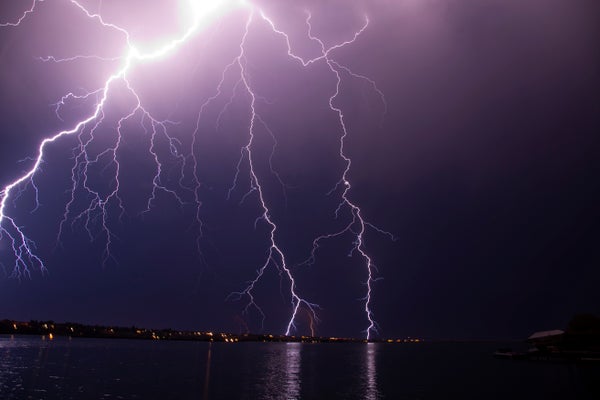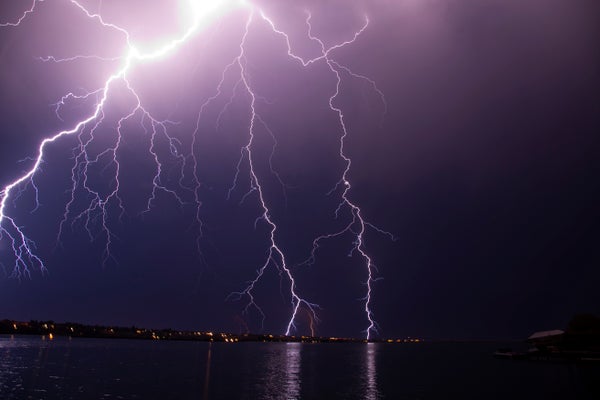October 21, 2024
4 min read
Mysterious Gamma-Ray Flashes May Be Missing Link for Lightning Bolts
Observations from a retrofitted spy plane hint at a connection between powerful gamma-ray flashes and a thunderstorm’s lightning

Stuart Westmorland/Getty Images
It’s said that lightning never strikes the same place twice and a watched pot never boils.
But neither statement is true—especially when your “pot” is an enormous tropical lightning storm bristling with thunderbolts and you’re watching it from far above in the stratosphere. Two recent studies in Nature found that some storms are indeed at a rolling boil—one that emits powerful bursts of gamma rays, not steam. And some of these emissions occur in mysterious, previously unrecognized patterns, split-second flickers that seem to spark ordinary lightning discharges.
“How lightning gets started inside thunderstorms is a big mystery,” says Joseph Dwyer, a physicist at the University of New Hampshire, who served as a reviewer for both studies. “Decades of balloon and aircraft measurements have failed to find electric fields inside storms large enough to make a spark, and yet thunderstorms manage to make more than eight million flashes per day around the planet. We are clearly missing something important. These new observations could be that ‘something.’”
On supporting science journalism
If you’re enjoying this article, consider supporting our award-winning journalism by subscribing. By purchasing a subscription you are helping to ensure the future of impactful stories about the discoveries and ideas shaping our world today.
Scientists have long known that thunderstorms can produce gamma rays, extremely high-energy light that is more often associated with astrophysical phenomena, such as exploding stars and matter-devouring black holes. In earthly tempests, the physics behind such emissions is relatively well-understood: swirling, windblown water droplets and ice crystals build up an electric charge within a storm, with positively charged particles rising to the cloud tops and negatively charged ones sinking to the bottom. This results in a sprawling electric field on the order of 100 million volts—powerful enough to accelerate electrons inside the storm to nearly the speed of light, slamming the charged particles into air molecules that give off further electrons and setting off a cascade of collisions so energetic that gamma rays are ultimately produced.
Researchers had observed two forms of thunderstorm gamma-ray emissions: relatively long-lived “glows” lasting hundreds of seconds, as well as intense, microsecond-scale bursts known as terrestrial gamma-ray flashes (TGFs), bright enough to be visible to Earth-observing satellites.
But scientists also knew this picture was incomplete, built as it was on piecemeal readings from airborne and ground-based instruments. “We still have significant uncertainties in the electrical nature of storms, from the details of how charge is separated by particles within the cloud to the physics of lightning initiation and channel development,” says Vanna Chmielewski, an atmospheric scientist at the National Oceanic and Atmospheric Administration’s National Severe Storms Laboratory, who was not involved in the new research. “Many of these processes are difficult if not impossible to accurately capture in a laboratory setting or model, given the number of contributing factors, known variability within even a single storm and limited observational datasets which can be used for validation.”
To get a clearer view, in 2023 a team led by Nikolai Østgaard and Martino Marisaldi, both atmospheric physicists at the University of Bergen in Norway, monitored the gamma-ray emissions of large storms from up close and on high, chasing down thunderheads with 10 flights of a NASA-owned modified U-2 spy plane over the Caribbean and Central America. The program, called ALOFT (Airborne Lightning Observatory for Fly’s Eye Geostationary Lightning Mapper Simulator and Terrestrial Gamma-Ray Flashes), constitutes the most comprehensive and focused airborne surveillance of thunderstorm gamma-ray emissions yet performed.

NASA’s high-flying ER-2 aircraft (a retrofitted U-2 spy plane) carries instrumentation in this artist’s impression of the ALOFT mission to record gamma rays (colored purple for illustration) from thunderclouds.
“ALOFT was designed to try to definitively answer the question ‘Are these gamma-ray flashes and glows common or rare?’” says Steve Cummer, an electrical engineer at Duke University and co-author of both studies. “And it delivered big time…. The gamma-ray production process is way, way more important than we thought.”
The flights revealed glows and TGFs, as expected, but also much more: Both phenomena proved far more abundant than predicted, with most of the TGFs being dim enough to escape the notice of any overwatching satellites. The glows also weren’t steadily emanating from isolated regions in the storms as anticipated but rather bubbled up in surges of radiation for hours across regions about 100 kilometers wide. And amid the hundreds of recorded events, the researchers also glimpsed something new—so-called flickering gamma-ray flashes (FGFs), pulsing spikes of emission that lasted for milliseconds and seemed to spring from glows. Most intriguingly, Østgaard says, “all the transient gamma-ray events were followed by intense lightning.”
The dynamism and large volume of these high-energy events, the researchers say, hint that the electron avalanches at their source act to limit a thunderstorm’s large-scale electric fields, in addition to spurring lightning production. “Thunderstorms are generating so much ionizing radiation that they partially discharge themselves in some regions, causing the electric fields to shoot up in other regions within the storm,” Dwyer says. “These field enhancements could be large enough to initiate lightning.”
Altogether, Marisaldi says, the ALOFT results paint a new, more nuanced picture that demands follow-up studies. “The acceleration of charged particles to relativistic energies within thunderclouds, for which gamma rays are a proxy, is an intrinsic and very common process, at least in convective tropical clouds,” he says. “Our observations suggest an intriguing hypothesis: a glowing thundercloud might be a prerequisite for lightning initiation. The glow can evolve locally in unstable phenomena—such as FGFs and TGFs—leading to the inception of lightning. We are eager to test this hypothesis with another flight campaign.”
Future flights, he says, could examine the emissions of storms at higher latitudes, as well as investigate two other major tropical hot spots for lightning, located in Central Africa and Southeast Asia.

